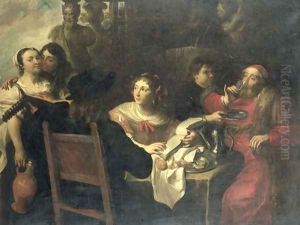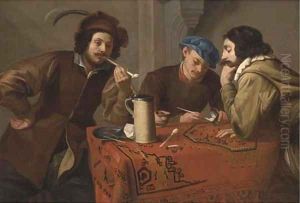(circle of) Rombouts, Theodor Paintings
Theodor Rombouts was a prominent Flemish painter who played a significant role in the Baroque movement, an era characterized by dramatic expression and grandeur in the arts. Born in 1597 in Antwerp, a city renowned for its artistic vitality, Rombouts was part of a bustling community of artists and craftsmen. His work is often associated with the Caravaggisti, a group of artists influenced by the revolutionary Italian painter Caravaggio, whose use of chiaroscuro and dramatic realism marked a significant departure from the Mannerist style that preceded him.
Rombouts' early life was immersed in the rich cultural and artistic environment of Antwerp, where he was initially trained by his father. Eager to expand his artistic horizons, he traveled to Italy in his early twenties, a journey that was crucial in shaping his stylistic development. In Italy, particularly in Rome, Rombouts was exposed to the works of Caravaggio and his followers. The dramatic interplay of light and shadow, as well as the intense emotional expressions found in Caravaggio's work, left a lasting impression on him. Upon his return to Antwerp around 1625, Rombouts began to incorporate these elements into his own paintings, thereby introducing Caravaggesque elements to the Flemish art scene.
Rombouts' oeuvre mainly consists of genre scenes, religious compositions, and portraits, marked by a robust use of color, dynamic compositions, and a keen eye for detail and character. His genre scenes, often depicting musicians, card players, or brawls, are particularly noted for their vitality and realism, reflecting the social life of his time. These works not only display his mastery of Caravaggesque chiaroscuro but also incorporate a distinctly Flemish sense of detail and texture.
Despite his relatively short life, passing away in 1637 at the age of 40, Rombouts left a significant mark on the Baroque period in Flanders. His work bridged Italian influences with Northern European traditions, contributing to the evolution of Flemish Baroque painting. Rombouts' legacy is seen in the influence he had on his contemporaries and the generation of artists that followed, helping to perpetuate the Baroque spirit in Flemish art beyond his own lifetime.

